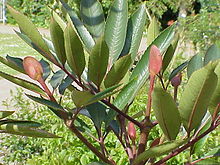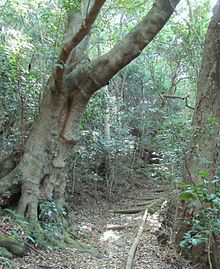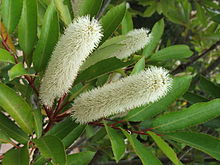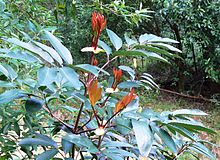- Cunonia capensis
-
Cunonia capensis 
Its distinctive spoon-shaped stipules give the tree its common name. Scientific classification Kingdom: Plantae (unranked): Angiosperms (unranked): Eudicots (unranked): Rosids Order: Oxalidales Family: Cunoniaceae Genus: Cunonia Species: C. capensis Binomial name Cunonia capensis
L.Cunonia capensis (the Butterspoon tree, Butterknife tree, African Red Alder or Rooiels) is a small tree, found in the afromontane forests of Southern Africa, and along rivers.
It is grown as an ornamental in gardens for its attractive glossy foliage and its clusters of tiny, scented, white flowers.
Contents
Appearance
Cunonia capensis is a beautiful specimen tree, especially for Southern African gardens. Its foliage is glossy, with tints of red, and it produces sprays of dense, fragrant, cream flowers from February to May. The flowers are bisexual and attract butterflies and honey bees. The fine seeds appear in tiny two-horned capsules and are dispersed by birds and by the wind.
The large stipules which enclose the growth tip are pressed together to form a spoon-like shape, giving the tree its common name of "Butterspoon Tree".
This evergreen garden tree does not grow well in extremely hot, arid conditions, as it prefers a slightly more temperate climate. It tolerates some frost and it is very fast-growing - provided it has sufficient water. In the open sun it typically reaches about 5 meters, but in forests it can grow up to 10 meters high.
Distribution
Cunonia capensis naturally ranges from Cape Town and the Western Cape of South Africa, eastwards all the way to Swaziland and southern Mozambique. It typically grows in the indigenous Afromontane forests of Southern Africa, and especially beside rivers.
The greater Cunonia genus has a disjunct natural distribution, with the bulk of its 30 species occurring only on the island of New Caledonia in the Pacific, and one single species (Cunonia capensis) all alone in Southern Africa. This bizarre distribution of species is probably due to plate tectonics (continental drift), as both regions were once adjacent parts of the Gondwana supercontinent.
Cultivation
Cunonia capensis is increasingly cultivated across Southern Africa as an ornamental specimen tree. It is cultivated for its glossy foliage which is tinted with red, and its sprays of cream flowers.
It grows well both in the sun and in the shade, and it can be planted near to buildings because it has a gentle, non-invasive root-system. This has recently made it popular in built-up areas. It requires a moist environment though, so trees planted in arid areas need frequent watering (especially while still small). However, this has also made it a very suitable tree for marshy, water-logged gardens, or next to rivers. The tree is usually cultivated from the tiny seeds. The young plants need lots of water and some shelter from direct sunlight.
It is one of the fastest growing trees in Southern Africa. [1]
References
Further reading
- Kubizki, Klaus ed. (2004). Flowering Plants, Dicotyledons: Celastrales, Oxalidales, Rosales, Cornales, Ericales (The Families and Genera of Vascular Plants, Volume VI). Springer, Berlin.
- Missouri Botanic Garden TROPICOS Nomenclatural Database. Accessed December 28, 2007.
Categories:- Cunoniaceae
- Afromontane
- Flora of South Africa
- Flora of Southern Africa
- Garden plants of Southern Africa
- Trees of South Africa
- Trees of Cape Town
- Ornamental trees
- Trees of Mediterranean climate
- Plants described in 1759
Wikimedia Foundation. 2010.



